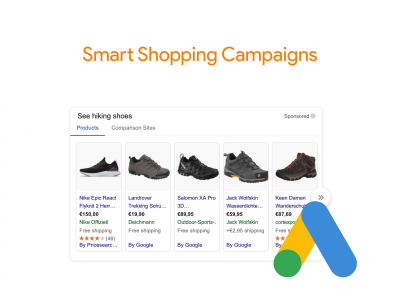Reach and popularity of Google Shopping Ads (aka Product Listing Ads) in retail search has skyrocketed. PLAs in Q1 of 2018
- 76% of retail ad spend in the US
- 82% of retail ad spend in the UK
Google Shopping has become the most popular ad format for

“The bigger picture here is the shift in how audiences are consuming new ad formats. As retailers move ad spend into Google Shopping, those who innovate will shape consumers’ future ad experiences” Ashley Fletcher – VP Marketing, Adthena
Google Shopping Ads are arguably one of the best and proven advertising formats in driving revenue & consumer clicks to
Why are Google Shopping Ads performing so well?

Google Shopping ad formats have dramatically increased the depth & breadth of the traditional product listing ads that consumers are being served in their search-based purchase journeys. When consumers search and are shown a carousel of products with respective prices, consumers simply get a better “PICTURE” of what they want, “HOW MUCH” they should or want to pay. Not only this, but “WHERE”, from which websites, they can directly order from. In summary, Google Shopping pushes consumers further down the sales funnel, closer to conversion.
For

There is no wonder, then why
Next Generation Retail Ads – Smart Campaigns

Google advances retail advertising yet again by harnessing the power of automation and data-driven machine learning to maximize conversion value.
Remember – the data Google has on its users is expansive; from where you have been and how long it takes you to get to every location, to your interests and personal search history. This contributes to Google’s collective knowledge of consumers, what they want, what they look for, how they search and when.
Moreover, Smart Shopping Campaigns represent a new campaign type that bring together Google Shopping & Display Remarketing. Together, they increase sales impact & expand reach across ALL relevant Google platforms:
- Google Search including Shopping
- The Google Search Network
- The Google Display Network
- YouTube & Gmail
Smart Shopping Campaigns not only interpret purchase intent & search c
In summary, SSCs use more signals for every auction than any other bidding solution to make an informed and more accurate
Early Adopter with Promising Results – in Retail Advertising
Brazil-based Newlentes offers high-quality contact lenses at affordable prices with recognized reliability. As a pioneer in technology, they were excited to incorporate more automation and machine learning to drive better results. They launched the new Shopping campaign type, which resulted in
- 57% more revenue at a
- 61% higher return on ad spend (ROAS).
Turkey-based n11.com is an e-commerce platform that offers a wide range of apparel, electronics, and houseware products. Since they saw positive results with Google Shopping, they were excited to use the new USCs Shopping campaign type to improve performance. As a result, n11.com saw
- 23% more revenue at a
- 9% higher return on ad spend (ROAS)
Bottom Line – Lessons for Ecommerce Merchants
Marketers in the
Available for app major shopping systems such as Shopify, Woocommerce, Magento & PrestaShop.
*Adthena defines ‘retail search’ as search data categorized in the following Adwords taxonomies: apparel, beauty and personal care, health, home & garden, occasions & gifts and sports & fitness. Benchmark performance across 40m ads.
Interested in creating a Google Shopping Campaign? Visit emarketing to get started today.















